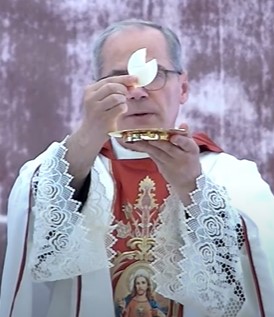- Home
- Our Community
- Our Faith
- Our Ministries
-
Parish Life
- Calendar of Events
- St. Aidan's Video Links
- Parish Blog
- News Archive
- Mass Etiquette and Information
- Ad Orientem News and Facts
- Catholic Links
- Prayers and Announcements
- Luis Dizon Reflections - Archive
- Bulletin
- Contact Us
- Search

Is it Still “Bread”? by J. Luis Dizon

Question: Catholics say that when the priests recite the words of institution at Mass, the bread and wine cease to be bread and wine, but become the body and blood of Christ. But Jesus still refers to the contents of the cup as wine (Matthew 26:29), and St. Paul still refers to the bread as bread (1 Corinthians 11:26). How can this be if they are no longer bread and wine?
Answer: The Catholic faith teaches that, upon consecration, the elements of bread and wine still retain the appearance (or “accidents”) of bread, but in terms of substance have been changed into the body and blood of Christ. This change is referred to as “Transubstantiation.” Fr. Steven in his homily for the feast of Corpus Christi gives an eloquent explanation for what this means, precisely.
However, astute readers of Scripture may notice that even after consecration, the elements are sometimes still referred to as bread and wine. In fact, in the Memorial Acclamation said during the Liturgy of the Eucharist, we sometimes repeat St. Paul’s words from 1 Corinthians: “When we eat this bread and drink this cup, we proclaim the Lord’s death until He comes” (italics mine). Non-Catholics sometimes use this observation as an argument against Transubstantiation, stating that if the elements are still referred to as bread and wine, then they must still be bread and wine.
In response to this, it must be observed that Scripture frequently refers to things by how they appear, rather than what they really are. For example, in St. Mark’s account of the Resurrection, he states that a young man wearing a white robe appeared in Jesus’ tomb (Mark 16:5). Now, this man was not really a man, but an angel appearing as a man. However, because his appearance was that of a man, Mark refers to him as such. St. Luke does the same when he says that when Jesus ascended into heaven, “two men stood by them in white robes” (Acts 1:10). These were not really men, but angels, but since they appeared as men, Luke refers to them as such.
The same can be applied to the Eucharist. We still refer to the elements as bread and wine, in virtue of what they appear to our senses. Even though the elements are no longer bread and wine, they retain all the physical and chemical properties of bread and wine. If one looks at a host under the microscope, one will still see carbohydrates and amino acids that make up bread. But make no mistake: Each of those carbohydrates and amino acids truly has the substance of Christ.
But this doesn’t mean God cannot cause the external appearance to change as well. If He wanted to, He could. And in fact, He has. Many such “Eucharistic Miracles” have occurred throughout history, where the outward appearance of the host changes to that of real flesh and blood. And these miracles have been confirmed by scientists. In this way, God has confirmed through signs and wonders to a skeptical world that Christ is indeed present on our altars and in our tabernacles, so that we not doubt, but believe wholeheartedly that He is there, and revere Him accordingly.
